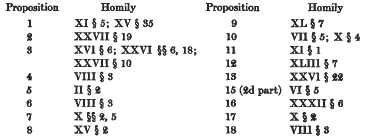Article contents
The Messalians; and the Discovery of their Ascetic Book
Published online by Cambridge University Press: 03 November 2011
Extract
The publication in the “Harvard Theological Studies” in 1918 of Macarii Anecdota, consisting of seven new homilies attributed to St. Macarius of Egypt, has revived interest in the mystery surrounding the authorship of the Macarian writings, and this renewed interest has given birth to a discovery. The controversy over the authorship of these writings is—at least in main outline—at an end. We now know in what age, in what region, and in what school of thought they were produced. The actual individual who penned them remains unknown. Hopes of completing the discovery by tracking him down have led the present writer to defer the composition of this article until now. These hopes however will probably not be realized until a good many years of research have been expended. It seems therefore fitting to publish the discovery in its general form. In brief, the Homilies attributed to St. Macarius are really the work of an heretical sect of mendicant monks and mystics called Messalians, or Euchites.
- Type
- Research Article
- Information
- Copyright
- Copyright © President and Fellows of Harvard College 1926
References
1 De Viris Illustribus 10, written according to Czapla in 467–480.
2 See also an article by Wilmart, A., entitled ‘La Lettre spirituelle de l'abbai Macaire,’ in Revue Ascétique et Mystique, January 1920.Google Scholar
3 Migne, XXXIV, cols. 409–442. See Villecourt, L., ‘La Grande Lettre Grecque de Macaire. Ses formes textuelles et son milieu littéraire,’ in Revue de l'Orient Chrétien, April 1920.Google Scholar
4 Migne, XXXIV, cols. 449–822; Harvard Theological Studies V, 1918.
5 Migne, XXXIV, cols. 821–968.
6 Joannis Arndtii De vero christianismo, cura et studio Ant. Wil. Boemi, 1708, Praefatio p. xvii.
7 P. Poiret, Bibliotheca mysticorum selecta, Amsterdam apud Wetstenios, I. Theol. mysticae idea generalis, p. 289 n.
8 Gothofredi Arnoldi Historia et descriptio theologiae mysticae, Frankfort, Thomas Fritsch, 1702, c. xi, sect. 5.
9 Wesley, John, A Christian Library, vol. i, 1819, etc.Google Scholar
10 They have of course nothing to do with Marseilles, the ancient Massilia, nor with Messina, the ancient Messana from which the family of Marcus Valerius Messala is said to have derived its surname. The name is taken from the Syriac meṣallein, εὐχῖται, ‘praying men.’
11 Mansi, Conciliorum omnium amplissima collectio (Latin text), t. iv, col. 1477; (Greek text), t. xii, col. 1025.
12 Photius, Cod. LII, Migne, CIII, cols. 88–92.
13 The attribution to St. Macarius is found as early as A.D. 534, that being the date of the Syriac Ms. Add. 12175 in the British Museum.
14 Epiphanius (died 403), Adversus haereses, lib. iii. t. ii, haeresis 80, Migne, XLII, 2, cols. 156–773.
15 Theodoret (386–458), Hist. Eccl. iv. 10, Migne, LXXXII, col. 1141; Haereticarum fabularum compendium, lib. iv, Migne, LXXXIII, cols. 429–432.
16 Timothy of Constantinople, De receptione haereticorum, Migne, LXXXVI, 1, cols. 45–52.
17 John of Damascus, De haeresibus liber, 80, Migne, XCIV, 1, cols. 728–737.
18 The proposition stops here in the syllabus of St. John Damascene. The words in brackets are supplied from Proposition 7 in Timothy's list.
19 Hom. LVI, sect. 1, from the Scala of Johannes Climacus, gradus xxvii, schol. 27 (Migne, LXXXVIII, col. 1124); sect. 4 from the same Scala, gradus xxvii, schol. 11 (Migne, col. 1104), Isaac of Nineveh.
20 ‘Homélies spirituelles attribuées a Macaire,’ Comptes rendus de l'Académie des Inscriptions et Belles Lettres, 6 Aug. 1920.
21 Mason, A. J., Fifty Spiritual Homilies of St. Macarius, S. P. C. K., 1921, p. 66.Google Scholar
22 Gavin, F., ‘The Sleep of the Soul in the Early Syriac Church,’ Journal of the American Oriental Society, vol. 40, 1920.CrossRefGoogle Scholar
23 Hom. LII, sect. 3, τὸ σπέρμα γὰρ τὸ θεϊκὸν ὁ Λόγος, ὁ πεσὼν εἰς τὴν θεοτόκον Μαρίαν.
24 A list of passages in the Fifty Homilies containing the doctrine stigmatized in the Propositions may be useful: 
25 A large number of homilies of ‘Macarius,’ according to Villecourt, are preserved in Arabic under the name of St. Symeon Stylites. The ascription is also to be found in Greek. Thus Homily LI, which in the Harvard Homilies takes the form of a letter addressed to Symeon, is found in a Moscow Manuscript which attributes it to Symeon. See Codex Mosquensis 177 (320/cccvii), where Homily LI begins Συμεὼν τοῖς ἀγαπητοῖς. This fact was kindly brought to my notice by G. Mercati.
26 By Upper Mesopotamia we mean the country between the Tigris and Euphrates lying northwest of the Median wall, with Amida (Diarbekr) in the north and Edessa (Urfah) in the west; and we use the expression with special reference to the northwesterly portion, namely that part of the modern province of Aleppo which lies east of the Euphrates and part of Kurdistan.
27 See Propertius II. xxiii. 21, ‘Et quas Euphrates et quas mihi misit Orontes me iuverint.’
28 Fabricius-Harles, Bibliotheca, X, p. 696, “Scriptores in Photii Bibliotheca Massaliani, quos idem Photius memorat, sunt Adelphius, Agapius, auctor βιβλίου ἀσκητικοῦ.” The insertion of the word ‘Agapius’ appears to be due to a slip of the pen.
29 C. W. F. Walch, Historie der Kezereien, III, 481–536.
- 1
- Cited by




